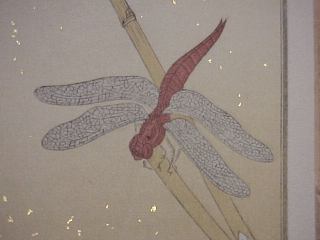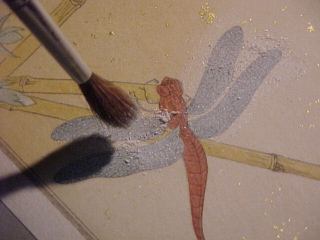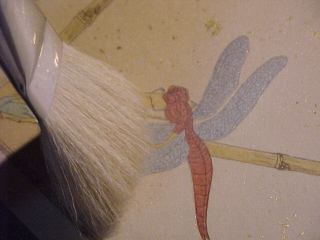Printing with Mica Powder
Adding 'sparkle' with mica
Another of the 'special' effects sometime seen on Japanese prints is the use of 'ummo', powdered mica. It is used to add a sheen to parts of the design, most commonly the background, but also to give a realistic effect to such things as metal ornaments, etc. In this example, I will use it to give a natural effect to the wings of a dragonfly in an Utamaro design ...
Mica powder is nearly transparent, so in order to give body to the finished impression, a base colour is usually printed first in the area that is to be covered with the powder. For this print, I first printed a light grey tone on the wings of the dragonfly (this was actually combined with the grey tone that highlighted parts of the body of the insect).

Once the undertone is done, the mica printing can begin. The first step is to brush glue over a block carved to match the area on which the mica is to appear. For this print I wanted to increase the iridescent effect of the insect's wings, so I mixed a small amount of blue pigment into the glue, which is a sticky gum arabic mixture.

Using a very gentle pressure with the baren, I 'printed' the glue mixture onto the paper. (Do not drive the glue down into the paper - the idea is to get a layer of glue right on the paper surface.)

An optional method is to cut a stencil of the appropriate shape, place it over the face of the print, and lightly brush the glue directly onto the paper. In either case, once the glue is on the paper, pick up some mica from the container with a soft brush and lightly dust it over the glued area. Don't worry about 'going over the lines'.

This step can also be done a different way - without the brush; just drop a small 'scoop' of powder onto the face of the print, then pick up the sheet in two hands and 'roll' it back and forth to let the powder fall in the proper place ...

Once the desired area has all been covered, dust off the excess mica powder with another soft brush, catching it on a clean sheet of paper so that it can be returned to the container.

Doesn't the mica powder stick to the paper in the wrong places? Only if the paper is very wet, and this is another reason why mica printing is usually done as the final step in the printing process. The paper can be allowed to dry out somewhat, and the excess powder thus brushes off easily. (If the paper is completely dry though, it will absorb moisture from the glue and 'wrinkle up' in that area ...)
Cover the print with a clean sheet of paper and lightly press the remaining mica into place, to help 'set' it into the glue.

Finish drying the print in the normal way. That's all there is to it ... hold it up to the light, and enjoy!


